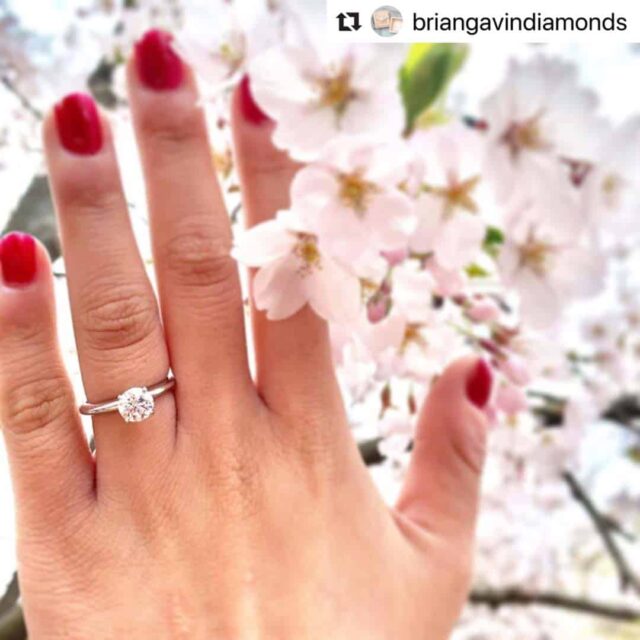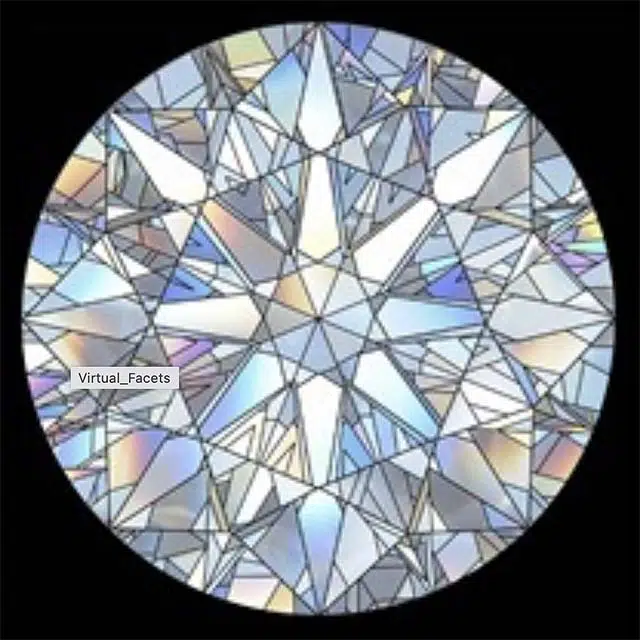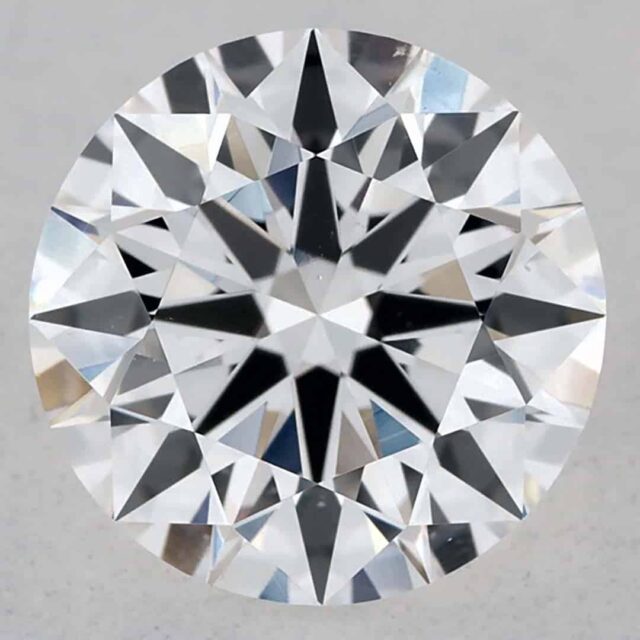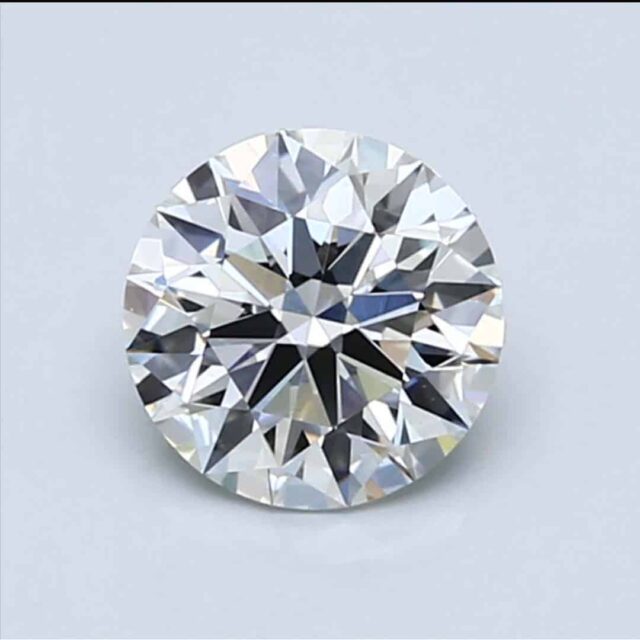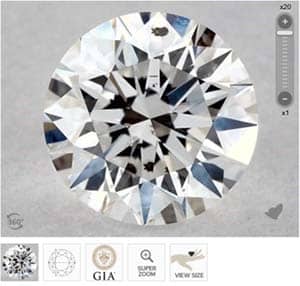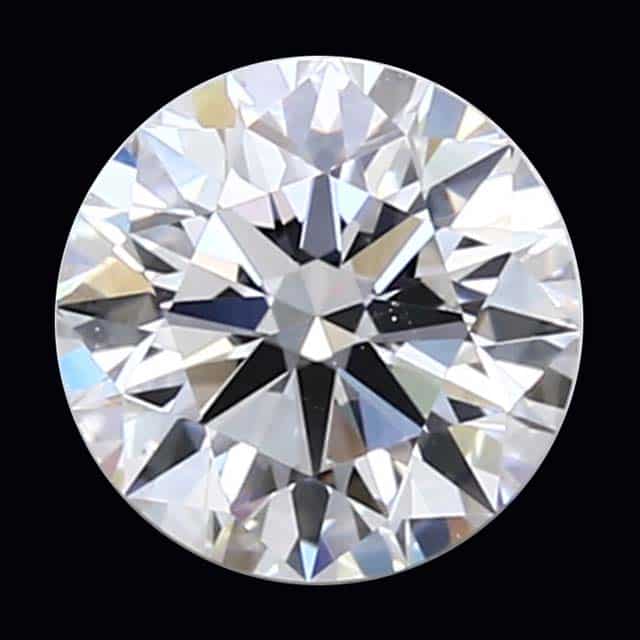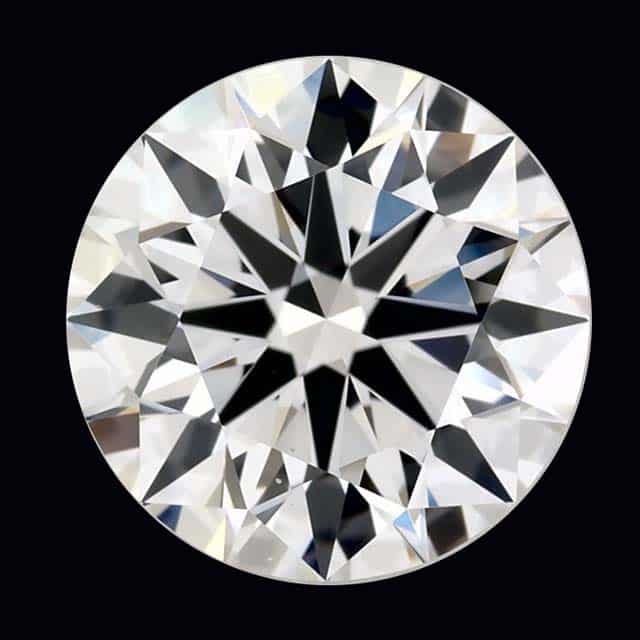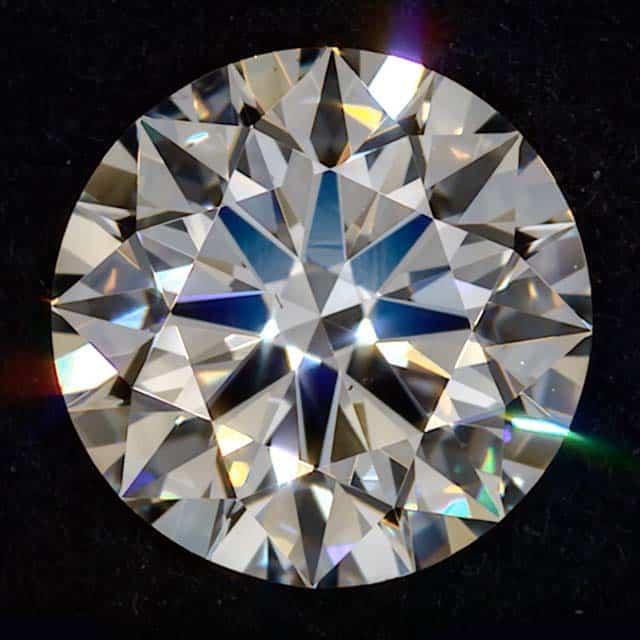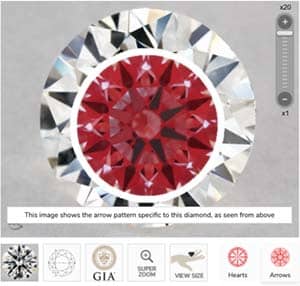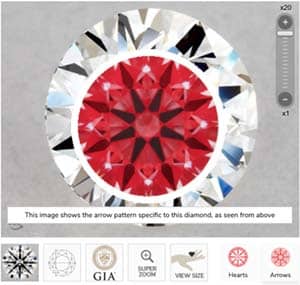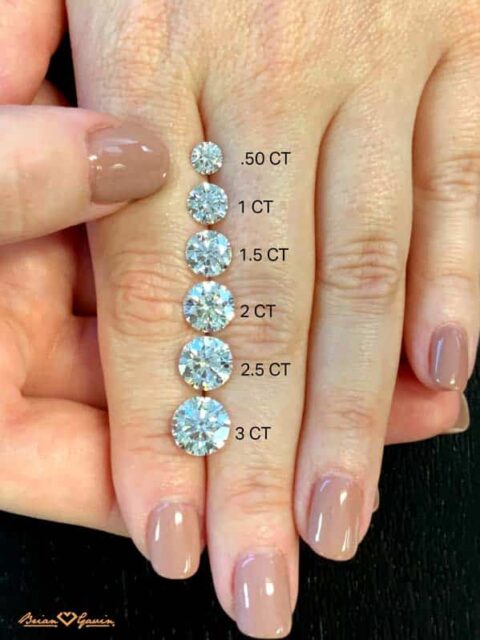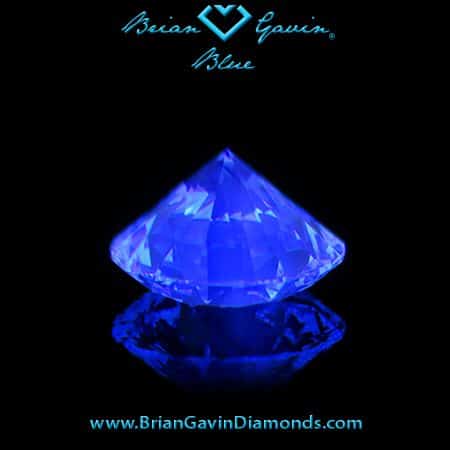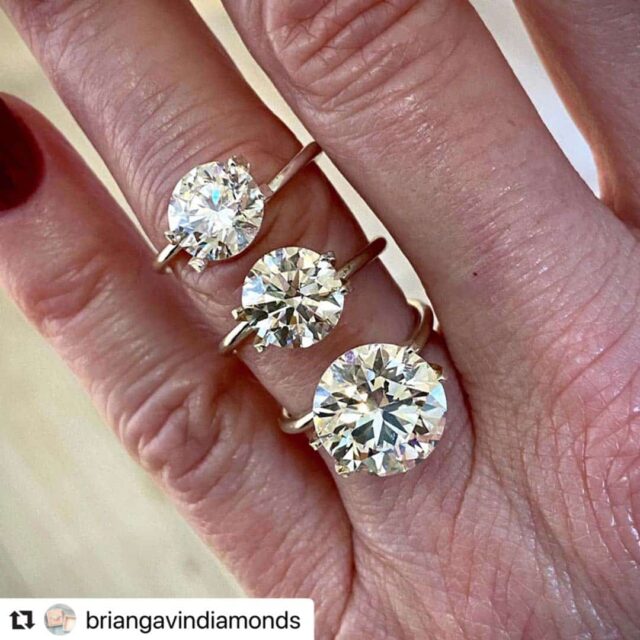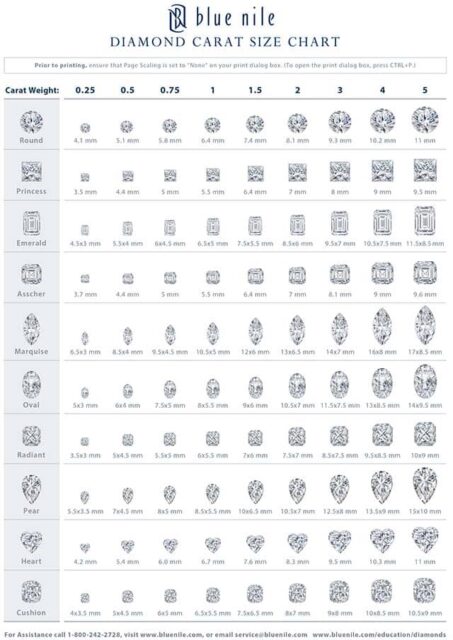Many think a 1 carat diamond ring provides the perfect balance of size and value. It's essential to remember that the sparkle factor is another crucial consideration.
This 1-carat diamond ring buying guide aims to ensure your ring sparkles like crazy! Below you'll find specific proportions that maximize the volume of light return and create a balance of brilliance and dispersion.
The pavilion angle dictates the light volume, while the crown angle determines the balance of brilliance and dispersion. Simultaneously, the degree of optical precision determines the intensity of the sparkle.
Optical precision is the consistency of facet shape, size, and alignment from the perspective of 360 degrees. Gemological laboratories like the AGS and GIA do not consider this factor.
However, we'll show you how to judge the light performance of one-carat diamonds using the images below. That way, you'll be able to buy a one carat diamond ring with confidence and peace of mind.
The Sparkliest 1 Carat Diamond Ring
The critical components of a diamond's sparkle factor are the number and intensity of reflections that the facet structure creates. Most people wrongly assume that a higher number of facets will make more sparkle.
In contrast, splitting the primary reflective surfaces into smaller facets only reduces the size of the sparkle. That appears to create more sparkle, but it will be less vivid and intense than light reflecting off of more significant facets.
Simultaneously, the effect of the smaller additional facets might make your 1-carat diamond ring look more brilliant, but it will be at the expense of fire. In other words, the sparkle factor will be whiter, but your one-carat diamond will have less dispersion.
The reason is that human eyes cannot disperse smaller-sized white spectrum reflections into colored light. In addition, the "virtual facets" resulting from the kaleidoscope effect of overlapping facets will be smaller in size.
Consequently, smaller sparkle tends to look less vivid and intense; it can also make diamonds look more like crushed ice. Modified brilliants like the Leo Diamond are marketed as brighter because the sparkle factor is whiter, but it's less intense than Hearts and Arrows diamonds.
Top Picks for a 1 Carat Diamond Ring
Black by Brian Gavin Diamonds represent the Pinnacle of Diamond Cutting today. They are the Ultimate in Light Performance and Sparkle Factor.
The 1-carat James Allen True Hearts diamond above exhibits a high volume of light return and a virtual balance of brilliance and dispersion.
This 1 carat Astor diamond from Blue Nile should exhibit a high volume of light return and a virtual balance of brilliance and dispersion.
The one carat diamonds above will light up your life like stars falling from the heavens. They have been hand-selected by Todd Gray, who has 35+ experience in the niche of light performance.
The primary difference is the degree of optical precision. That is the consistency of facet shape, size, and alignment. In that case, the sparkle factor will be more intense in the order of presentation from left to right.
How Much Does a 1 Carat Diamond Ring Cost?
As with most consumer goods, one-carat diamond rings are available at various prices. However, that does not necessarily mean that a cheap one-carat diamond ring is a good value.
For example, this 1.00 carat, G-color, SI-2 clarity, round brilliant cut diamond from James Allen costs only $800.00, so it's pretty cheap.
However, it also has a lot of negative characteristics that prevent it from looking good. To begin with, take a look at how the pattern of light does not reflect evenly. In that case, the diamond will have some dead zones.
There are also several large, black pique inclusions within this SI2 clarity diamond. In that case, you'll likely be able to see the inclusions without magnification.
Carat Weight is Only One Consideration
There is a lot of black obstruction under the table facet visible in the diamond shown above. In that case, the edge of the table facet will look dark.
Simultaneously, the arrow shafts are translucent and lack contrast brilliance because the main pavilion facets are not reflecting light properly.
In this case, the 41.4 degree pavilion angle is too steep to produce a high volume of light return. A pavilion angle between 40.6 - 40.9 degrees will provide better performance. Any deviation from that range will result in a loss of light return and more light leakage.
The visible outside diameter of a 1 carat diamond ring is also a critical factor to consider. In this case, the diamond has an average outside diameter of 6.37 mm. In contrast, a super ideal round 1 Carat Diamond measures closer to 6.4 mm in diameter.
That is why we recommend a total depth between 59 - 61.8%. Whereas the diamond shown above has a 62.8% total depth. As a result, that one-carat diamond looks smaller because the carat weight is hidden in the total depth.
Loose 1 Carat Diamond Prices
It stands to reason that one-carat diamond rings are available in practically every price range. However, it's also likely that you won't be happy with the least expensive options. After all, many characteristics factor into diamond prices, and carat weight is just the beginning.
Consequently, the overall cut quality of a one-carat diamond can affect the price by up to sixty percent. It's also essential to evaluate reflector scope images to judge diamond performance.
Remember that the overall cut grade on diamond grading reports does not account for optical precision. The AGS Ideal and GIA Excellent cut grades encompass a broad performance spectrum.
Under those circumstances, there is a wide range of cut qualities available online and in jewelry stores. Not only are there significant differences in quality and price, but also light performance.
Blue Nile 1 Carat Diamond Prices
Good Performance: This 1.02 carat, G-color, VS-2 clarity, GIA Excellent cut round diamond from Blue Nile costs about $8K. The 40.8 degree pavilion angle sets the stage for a high volume of light return. Meanwhile, the 35-degree crown angle should produce a virtual balance of brilliance and dispersion.
The black asymmetrical shapes between the arrow shafts under the table facet are obstructions and light leakage. Needless to say that this is going to make the edge of the table facet look dark. In that case, we're going to chalk this puppy up in the good category.
Actually, it's better than good since the overall cut rating is excellent. In fact, the center range proportions and GIA Excellent rating put it well within the Top 1% of the annual production of round diamonds. However, a higher degree of performance is available, as you will see momentarily.
James Allen 1 Carat Diamond Prices
Better Performance: You might be surprised to discover that the price of this James Allen True Hearts diamond costs less than the previous one from Blue Nile. In fact, this 1.02 carat, G-color, VS-2 clarity, James Allen True Hearts diamond is about $7.5K.
It's easy to see that light reflects more evenly throughout this one-carat diamond. In addition, it isn't showing any signs of obstruction under the table facet. The Ideal Scope image James Allen provides enables us to determine the amount of light leakage.
Here is a copy of the GIA diamond grading report. In this case, the 40.6 degree pavilion angle produces a high volume of light return. Simultaneously, the 35-degree crown angle should create a virtual balance of brilliance and dispersion.
Brian Gavin 1 Carat Diamond Prices
Even Better Performance: This 1.008 carat, G-color, VS-2 clarity, Brian Gavin Blue fluorescent diamond is $8K. It exhibits a higher degree of optical precision, as evidenced by how evenly light reflects the ASET Scope image.
Consequently, we have a copy of the Ideal Scope image for the James Allen True Hearts diamond mentioned above on file. In that case, we can back up that claim by showing that it is leaking a moderate amount of light under the table facet.
This diamond is graded by the AGS Laboratory on their proprietary light performance grading platform. The 40.8 degree pavilion angle is producing a high volume of light return. Simultaneously, the 34.7 degree crown angle creates a virtual balance of brilliance and dispersion.
In this case, it seems clear that the best one-carat diamond is the one from Brian Gavin. That's not surprising since he holds the patent for maximizing light performance in the modern round brilliant cut diamond.
Nevertheless, we still like to shop around to see who has the best one-carat diamonds available. After all, these diamonds are polished individually and have their own unique characteristics.
Look Beyond the Proportions
The proportions of the diamond dictate the volume of light return and the balance of brilliance and dispersion. However, the degree of optical precision determines the light performance and intensity of sparkle.
Things get tricky since the gemological laboratories do not grade optical precision. That means that you're going to have to determine that for yourself.
Fortunately, it's pretty easy if you have the following reflector scope images:
Although this may be true, most people will overlook the importance of this information and rely upon the overall cut grade. In doing so, they will miss a critical determining factor of light performance. As a result, the ideal cut diamond they buy will probably exhibit moderate light leakage.
How to Judge Light Performance
As stated previously, we use reflector scope images to judge the light performance of diamonds. In other words, we can use an ASET Scope or Ideal Scope image to determine the degree of light leakage.
As a matter of fact, an Ideal Scope can only be used to identify light leakage. The ASET Scope will also determine how bright a diamond will be and how evenly it reflects light.
Take a look at the Ideal Scope image on the left for this 1.01 carat, I-color, VS-2 clarity, James Allen True Hearts diamond, for example. The light pink semi-transparent sections visible along the edge of the table facet along the left side indicate a moderately high amount of light leakage.
Whereas there appears to be less light leakage along the edge of the table facet on the right side. You're probably looking for better performance from a one-carat diamond ring.
However, this diamond has an overall GIA Excellent cut rating. Here is a copy of the GIA diamond grading report. You might be surprised to discover that the measurements are only slightly beyond my preferred range of proportions.
Ideal Scope Shows Moderate Light Leakage
In the first place, I want to be clear that I'm not implying that all James Allen True Hearts diamonds leak a substantial amount of light.
As a matter of fact, the Ideal Scope image to the left is considerably better than the one above. Obviously, there is less light leakage because there are fewer light pink semi-transparent areas.
In that case, this 1.01 carat, G-color, VS-1 clarity, James Allen True Hearts diamond is a better choice. As a matter of fact, the proportions are also within the range that I recommend. Here is a copy of the diamond grading report.
However, the thing that is making the difference here is the degree of optical precision. That is the consistency of facet shape, size, and alignment from the perspective of 360-degrees.
The combination of tighter proportions and the higher degree of optical precision produce a higher volume of light return. In other words, this diamond is leaking less light because the facet structure is more precise.
At the same time, this one-carat diamond ring will exhibit a more vivid and intense sparkle. Higher optical precision will produce more virtual facets within the diamond. This will make a kaleidoscope-like effect of light that continuously reflects throughout the diamond more and more to create incredible spectral bliss.
Advanced ASET 30-40
As insightful as Ideal Scope images can be, the reality is that they are kind of obsolete. In other words, the only thing that an Ideal Scope image can tell us is the degree of light leakage. Whereas an ASET Scope image will tell us that and more.
As a matter of fact, we can use ASET to determine how evenly light reflects throughout a diamond. At the same time, the ASET map will indicate whether a diamond is gathering and reflects light back correctly.
The ASET Scope image for this 1.02 carat, F-color, VS-2 clarity, Black by Brian Gavin Diamond shows no indications of light leakage under the table facet. In other words, there are no indications of light leakage under the table facet.
As a matter of fact, the degree of hue and saturation is highly consistent. At the same time, the even distribution of colors shows that light is reflecting evenly throughout the facet structure.
We know that this diamond is cut to a higher degree of optical precision based on this information. Although this may be true, we'll still look at the Hearts & Arrows Scope image to know for sure.
Of course, Brian Gavin is the leading authority on Hearts and Arrows diamond cutting. As a matter of fact, he is the only diamond cutter globally with a patent for maximizing light performance in the modern round brilliant.
Brian Gavin incorporates the Advanced ASET map into their lab reports, which provides incredible insight when combined with ASET photographs like the one above.
How Big Is a One Carat Diamond Ring?
While the hand shot on the left is helpful to some degree, it still doesn't provide us with an accurate scale of reference. One reason is that the device you are reading this on will influence the visual scale.
Although it is still helpful to see what diamonds of different sizes look like on a hand. Consequently, the 1-carat diamond has an average outside diameter of about 6.5 millimeters. That is about the same size as the standard #2 yellow pencil eraser.
Read our in-depth tutorial on diamond carat weight for more information. It also includes a reference chart that will provide you with a visual reference for all the most popular shapes and sizes.
Where to Buy 1 Carat Diamond Rings
If you're shopping for an engagement ring, you might be feeling a bit overwhelmed. After all, there are essential decisions to make, not the least of which is how much to spend. You also have to decide whether you prefer a1-carat Tiffany solitaire or perhaps a halo setting or other ring style.
There is also an abundance of places to buy a 1 carat diamond ring. However, we think it's faster and more convenient to shop online. You can compare prices and quality easily, and the upgrade policies are better.
Although that may be true, it can still be overwhelming to figure out where to buy an engagement ring. After all, it can be challenging to know who to trust and what companies are reputable.
Fortunately, I have the experience to guide you through the process. Here is a list of our preferred vendors:
Best Places to Buy a 1 Carat Diamond Ring
Of course, we would love to help you search for diamonds. So, be sure to take advantage of our free Diamond Concierge Service. We'll help you search for diamonds that meet our selection criteria. That way, you can focus on doing whatever you do best.
What Is The Best Clarity for an Engagement Ring?
If you want the 1 carat diamond ring that you buy to face-up eye clean, I suggest VS-2 clarity. As a matter of fact, I think that the VS-2 clarity grade provides the best overall value.
An AGS or GIA graded VS-2 clarity diamond should face-up eye-clean. At the same time, you won't see a difference in higher clarity diamonds with the naked eye.
In that case, this 1.008 carat, G-color, VS-2 clarity, Brian Gavin Blue Fluorescent diamond is the perfect choice. In the first place, the proportions meet my selection criteria.
Secondly, the diamond exhibits higher optical precision, as evident in the ASET and H&A Scope images. Therefore, it will display a high volume of light return and broad-spectrum sparkle.
At the same time, there will be a virtual balance of brilliance and dispersion. In addition, the G-color puts this diamond in the near-colorless range, so it's going to face up bright and white.
The medium blue fluorescence will only be visible under blacklight. However, it should also improve your perception of diamond color and make it seem whiter and brighter.
Choosing the Right Diamond Clarity Grade
The VS-2 clarity grade represents the sweet spot for an engagement ring. After all, it provides the perfect balance in that it will be eye-clean while being cost-effective.
Of course, you should also take the diamond clarity characteristics into account. As a general rule, you should avoid the following:
The SI-1 or SI-2 clarity grade might be a good option if you're trying to save money. However, it's essential to realize that you might be able to see some inclusions without magnification.
Of course, there are a lot of variables that dictate the likelihood of whether or not you will see the inclusions. Not the least is the degree of your personal vision and the nature of the clarity characteristics.
I've always been able to locate the inclusions within SI-1 clarity diamonds with just my eyes, especially after identifying the inclusions. As that may be, I still selected an SI2 clarity diamond for my wedding ring because it enabled me to afford a larger size.
Although I could easily see the inclusions, the sparkle factor made it difficult for anybody else to notice. In fact, people had difficulty seeing the inclusions even after I pointed them out.
Lower Clarity I-1 and Higher Clarity VS-1+ Diamonds
As a matter of fact, I tend to shy away from lower I-1 clarity diamonds because of the inclusions. After all, they're either going to make the diamond look heavily included or present a durability risk.
With that in mind, I tend to lean towards higher clarity diamonds. At the same time, I don't personally see a need to spend more for anything higher than VS-2 clarity.
After all, you won't see the difference between VS-2 and VS-1 clarity with the naked eye, so why spend the money? Unless you prefer a higher clarity diamond from the perspective of keeping things mind-clean.
What Is The Best Color for a 1 Carat Diamond Ring?
On the condition that you're buying a white diamond, the body color is less critical than you might imagine. That is, of course, assuming that the cut quality of the diamond is on the higher end of the spectrum.
Under those circumstances, the sparkle factor will make it more challenging to focus on the body color. As a matter of fact, I think that diamond color is the least important factor to consider.
First, it's essential to remember that diamonds are transparent crystals. In that case, there is a big difference between solid Crayola Crayon and diamond colors.
Secondly, our perception of diamond color constantly changes in response to the environment. In other words, a diamond reflects every color in the room, including the walls and decorations.
The color of the metal touching the edge of the diamond can also influence our perception of color by about one grade. Setting a G-color diamond in white metal prongs, for example, makes it look closer to F-color.
Slight Differences in Color Equal Big Savings
Take a look at the Brian Gavin Signature diamonds above. Although they look similar, they are three color grades apart.
- 1Top: 2.116 carat, K-color, VVS-1 clarity;
- 2Middle: 2.305 carats, L-color, VS-2 clarity;
- 3Bottom: 5.388 carats, J-color, VS-2 clarity.
That is an excellent example of why I place the most importance on diamond cut quality. After all, that will dictate the volume of light return and the sparkle factor.
Subtle differences in color or clarity will not be apparent across the dinner table. However, the proportions and degree of optical precision will affect how your one-carat diamond ring looks from across the room!
Popular Shapes for 1 Carat Diamond Rings
A 1 carat diamond ring will look good in any shape as long as it is cut well. In that case, the diamond shape you choose is primarily a matter of personal preference.
Although that may be true, the modern round brilliant is the most popular. In the first place, the symmetrical shape of the round-brilliant provides for the highest volume of light return.
Secondly, the symmetrical facet structure makes it easier to distribute the light evenly throughout the diamond. The facet lengths differ significantly in fancy-shaped diamonds, affecting the light return.
Consequently, you might prefer a fancy-shaped diamond if carat weight is your primary concern. That is because fancy-shaped diamonds tend to cost less per carat than rounds.
However, you will probably have to buy a more considerable fancy to match a round diamonds' surface area. That's because fancy shapes are cut deeper, so they face up smaller per carat.
The chart above shows the relationship between one-carat diamond rings of different shapes. In that case, you'll see how the diamond shape influences our perception of size.
Examples of 1 Carat Diamond Rings
It always helps to have inspiration when shopping for one-carat diamond rings. Especially if you tend to be more visual like I am and like to see what things look like. In that case, here are some examples of popular styles:
1 Carat Diamond Solitaires:
Pavé Style Engagement Rings
1 Carat Diamond Halo Settings
Vintage Inspired Engagement Rings
Wrapping Up Your 1 Carat Diamond Ring
Shopping for a 1 carat diamond ring is easy now that you know what to look for. Remember that the most critical factor is the cut quality of the diamond.
After all, that will determine the volume of light return and the sparkle factor. Although that may be true, we recognize that searching for diamonds can be daunting.
However, it doesn't have to be complicated or time-consuming. Take advantage of our free Diamond Concierge Service, and we'll do most of the heavy lifting.
After all, we know what to look for and have the resources available to run searches quickly and effectively. Just let us know the range of characteristics and price you are looking for.

